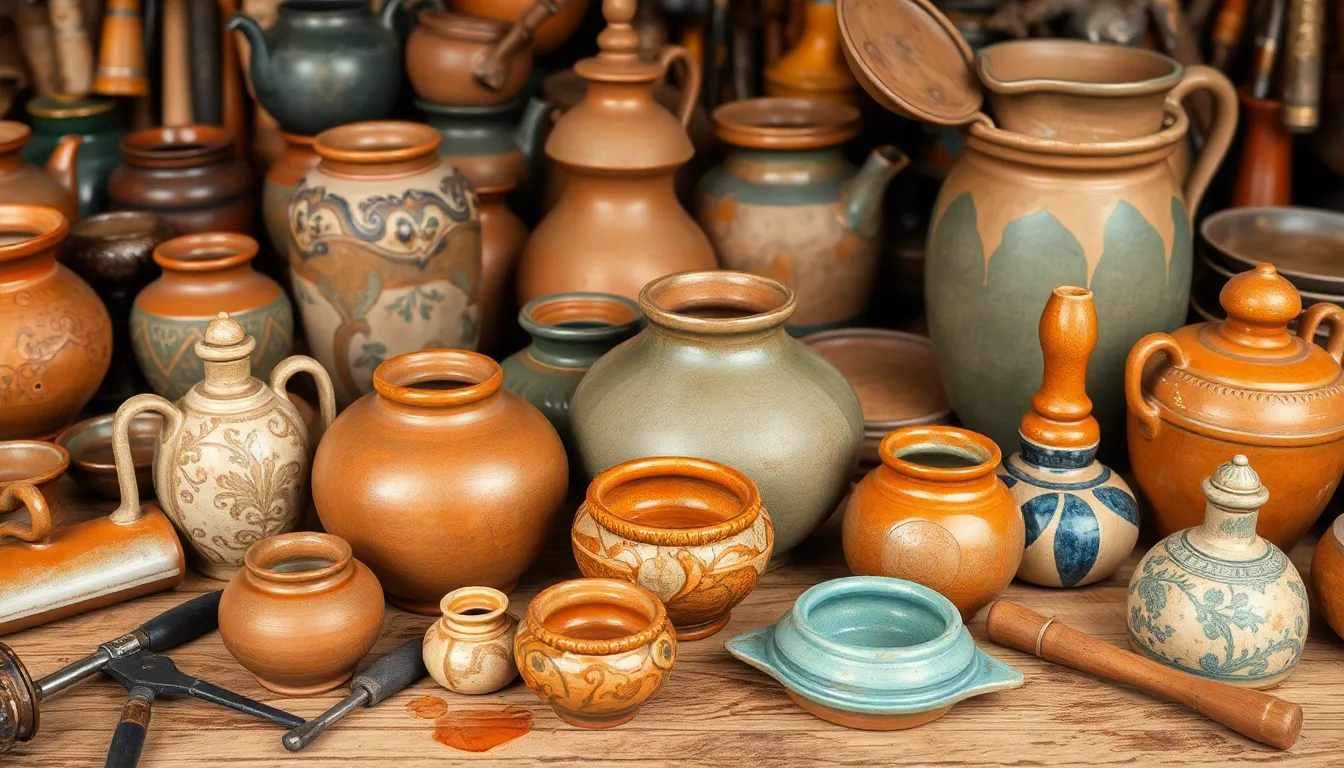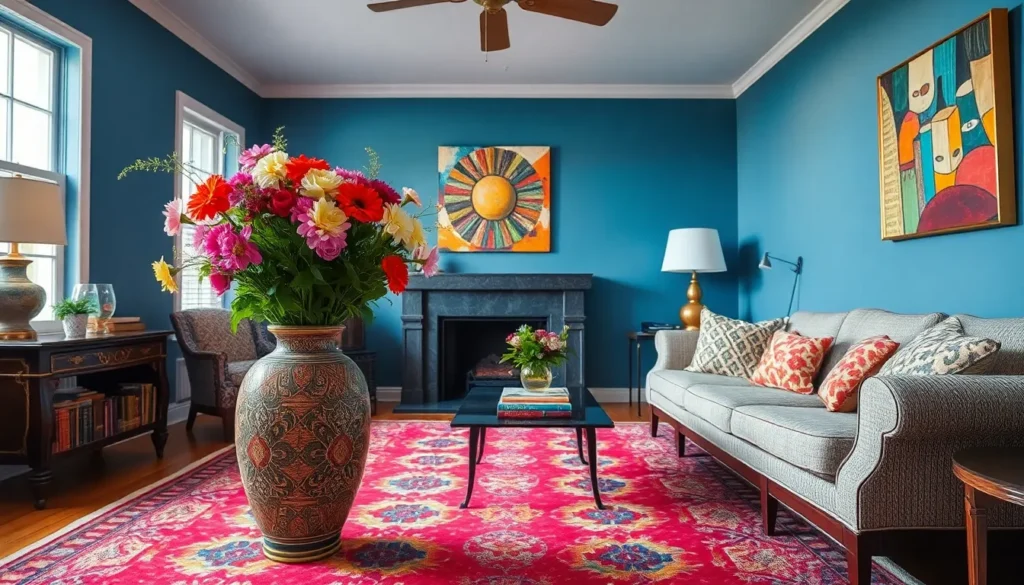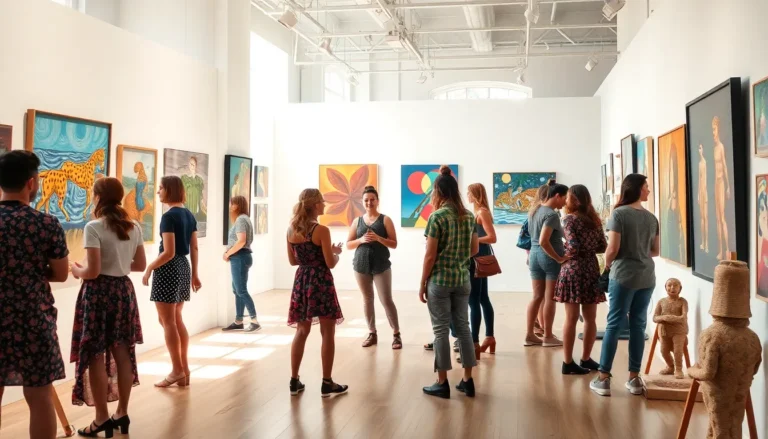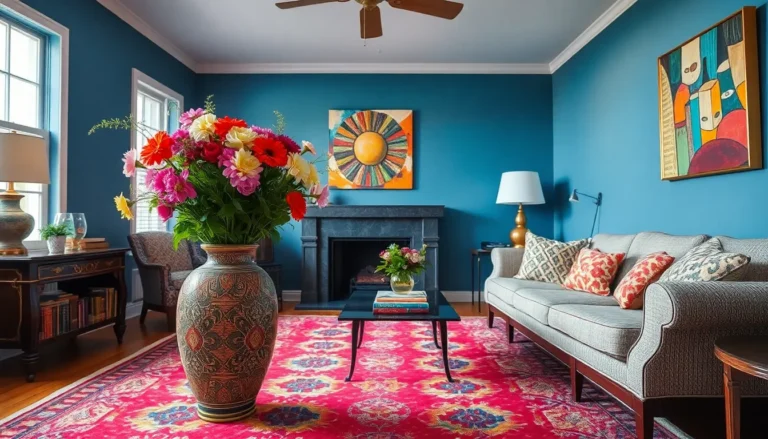Table of Contents
ToggleDecorative arts might sound like a fancy term reserved for snooty galleries, but it’s so much more than that. Think of it as the art of making everyday life a little less ordinary. From that quirky vase that sparks joy to the stunning wall art that makes guests do a double-take, decorative arts transform spaces into reflections of personality and style.
In a world where minimalism reigns, decorative arts remind us that a little flair never hurt anyone. They’re the unsung heroes of our homes, adding color, texture, and a dash of whimsy. Whether it’s a hand-painted plate or a sculptural lamp, these pieces do more than just sit pretty—they tell stories and spark conversations. So, let’s dive into the vibrant universe of decorative arts and discover how they can elevate not just our spaces, but our everyday experiences.
Overview of Decorative Arts
Decorative arts encompass a wide range of artistic expressions, focusing primarily on functional objects. Items such as ceramics, textiles, and furniture play an essential role in enhancing environments. Craftsmanship and design principles guide the creation of these objects, ensuring both utility and aesthetic appeal.
Incorporating decorative arts can transform living spaces, making them more vibrant and inviting. Colorful rugs, intricate wall hangings, and unique sculptures add personality to homes. Beyond mere decoration, these items often serve as conversation starters, showcasing individual taste and creativity.
Historical significance also underlies many decorative arts, reflecting cultural values and societal norms. Collecting decorative pieces connects individuals to various art movements, from Art Nouveau to Bauhaus. Knowledge of these styles deepens appreciation for the craftsmanship involved.
Artisans continue to innovate, blending traditional techniques with contemporary design. This fusion results in pieces that not only serve practical purposes but also resonate emotionally with their owners. Unique artworks can evoke feelings, memories, and a sense of belonging, enriching everyday experiences.
Understanding the role of decorative arts in personal spaces encourages more thoughtful choices. Investing in quality items contributes to environmental aesthetics and demonstrates an appreciation for artistry. Whether through museum-quality pieces or handcrafted items from local artists, decorative arts invite individuals to curate their surroundings creatively.
Historical Context

Decorative arts possess a rich historical backdrop that underscores their evolving significance in various cultures. They serve as a reflection of societal values, artistic innovation, and aesthetic preferences over time.
Ancient Decorative Arts
Ancient civilizations placed immense value on decorative arts, using them to convey status and cultural identity. Egyptians adorned their tombs with intricate pottery and textiles, showcasing craftsmanship and religious beliefs. Similarly, Greeks and Romans created functional yet aesthetically pleasing items, integrating sculpture and painting into architecture. These artifacts not only served practical purposes but also highlighted the artisans’ skill and artistry, revealing how decorative arts were integral to daily life.
Evolution Through the Ages
Decorative arts underwent significant transformation during various historical periods. The Middle Ages saw a move towards ornate designs in illuminated manuscripts and church artifacts, reflecting the era’s spiritual values. With the Renaissance, a renewed focus on humanism led to exquisite furniture and textiles that celebrated beauty and innovation. The Industrial Revolution marked a shift toward mass production, yet it didn’t diminish the appreciation for craftsmanship. Contemporary decorative arts blend traditional techniques with modern aesthetics, keeping the spirit of innovation alive while resonating with personal expression.
Key Elements of Decorative Arts
Decorative arts encompass various components that contribute to their richness and appeal. Understanding these key elements illuminates their role in creating inviting spaces.
Materials Used
Ceramics, glass, metal, textiles, and wood constitute the primary materials within decorative arts. Each material brings unique qualities, shaping the final product’s look and feel. Ceramics lend themselves to intricate designs, while metal offers durability and strength. Textiles like silk and wool provide versatility and warmth, making them ideal for decorative applications. Glass adds elegance and transparency, often used in lighting fixtures and window treatments. Wood brings warmth and natural beauty, frequently featured in furniture and accents. The combination of these materials leads to innovative artistic expressions that captivate and inspire.
Techniques and Processes
Craftsmanship and design techniques play critical roles in decorative arts. Handcrafting methods such as weaving, carving, and glazing enhance the uniqueness of each piece. Weaving results in stunning textiles, showcasing intricate patterns and textures. Carving, commonly seen in wood and stone, highlights the skill and attention to detail of artisans. Glazing techniques in ceramics create vibrant colors and smooth finishes, transforming functional objects into works of art. Contemporary artists often incorporate modern technologies alongside traditional methods, fostering innovation and creativity in the field. Each technique reflects an artist’s vision, connecting history and contemporary design.
Major Movements in Decorative Arts
Several significant movements shaped the evolution of decorative arts, each reflecting distinct artistic philosophies and cultural changes.
Arts and Crafts Movement
Rooted in the late 19th century, the Arts and Crafts movement emphasized handcrafted quality over mass production. Designers like William Morris championed natural materials and traditional techniques, aiming to revive craftsmanship in everyday objects. Many sought to reconnect art with nature, inspiring a return to simpler forms and patterns. Their works often featured intricate designs, showcasing the beauty of materials like wood and textile. This movement not only highlighted the importance of artistry but also laid the foundation for future design trends that valued handmade authenticity.
Art Nouveau
Emerging in the late 1800s, Art Nouveau celebrated organic forms and decorative elegance. Artists like Alphonse Mucha and Gustav Klimt infused their designs with flowing lines and nature-inspired motifs. The movement focused on unity in design, merging architecture, furniture, and decorative objects seamlessly. Patterns often mirrored botanical and feminine forms, creating an ethereal quality. Art Nouveau’s innovative spirit extended beyond craft, influencing architecture and graphic design, thereby reshaping visual culture in the early 20th century.
Modernism and Postmodernism
Modernism began in the early 20th century, promoting functionalism and minimalism in design. Prominent figures such as Le Corbusier and Marcel Breuer aimed to strip away ornamentation, favoring simple solutions for modern living. An emphasis on materials like steel and glass reflected the technological advancements of the time. Postmodernism followed, reacting against the rigidity of modernism. It embraced eclecticism, humor, and individuality, allowing artists to incorporate historical references and diverse styles. This transition marked a significant shift, blending artistic freedom with a critique of established norms in decorative arts.
Contemporary Decorative Arts
Contemporary decorative arts reflect a dynamic fusion of tradition and innovation. Artists today incorporate various materials, including ceramics, wood, and textiles, creating unique pieces that enhance modern living spaces. Unique sculptures and vibrant textiles often serve as conversation starters, showcasing personal style and creativity.
Their influence extends far beyond aesthetics; contemporary decorative arts shape daily experiences through functionality and beauty. Designers embrace sustainable practices, reflecting a growing awareness of environmental impact. Items crafted from recycled materials not only promote green choices but also tell stories of their origins.
Many contemporary movements emphasize individual expression. For instance, artists in the Studio Craft Movement prioritize handcrafted quality, offering an alternative to mass production. The focus on artisanal skills invites appreciation for the labor and thought invested in each piece.
Emerging technologies also play a significant role. Some artists experiment with digital fabrication methods, merging traditional craftsmanship with cutting-edge designs. This approach enhances creativity while keeping artisanal techniques relevant in today’s market.
Cultural diversity informs contemporary practices as well. Global influences inspire innovative designs, bridging gaps between various artistic traditions. This mixture encourages a dialogue among artists, collectors, and audiences, broadening the appreciation for decorative arts globally.
Conversations surrounding contemporary decorative arts include the importance of curating personal collections. Thoughtfully chosen pieces, whether sourced from local markets or galleries, interact with individual narratives. Collectors celebrate their unique tastes through decoration, emphasizing that every item contributes to a larger story in their home.
Embracing decorative arts enriches daily life in ways that go beyond aesthetics. These artistic expressions infuse spaces with personality and creativity, transforming the ordinary into the extraordinary. By selecting unique pieces that resonate with individual tastes, one can create an environment that sparks joy and fosters connection.
The interplay between tradition and innovation in decorative arts reflects a rich cultural heritage while promoting modern sensibilities. As sustainability becomes increasingly important, the choice of materials and craftsmanship plays a crucial role in shaping contemporary design. Ultimately, the decorative arts invite everyone to celebrate their surroundings and appreciate the stories behind each piece, making art an integral part of everyday living.







